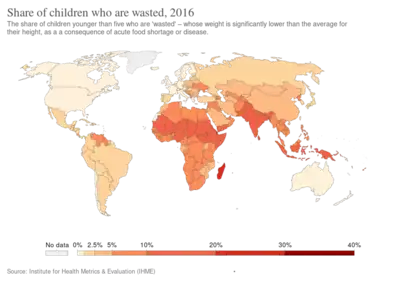Wasting

Wasting, also known as wasting syndrome, is when a disease causes muscle and fat tissue to decrease. Wasting is sometimes referred to as "acute malnutrition" because it is believed that episodes of wasting have a short duration, in contrast to stunting, which is regarded as chronic malnutrition.
An estimated 45 million children under 5 years of age (or 6.7%) were wasted in 2021.[1]: 4 Rates are highest in Southern Asia, followed by Oceania (excluding Australia and New Zealand) and South-eastern Asia.[1]: 14
Causes
Wasting can be caused by an extremely low energy intake (e.g., caused by famine), nutrient losses due to infection, or a combination of low intake and high loss. Infections and conditions associated with wasting include tuberculosis, chronic diarrhea, AIDS, and superior mesenteric artery syndrome. The mechanism may involve cachectin – also called tumor necrosis factor, a macrophage-secreted cytokine. Caretakers and health providers can sometimes contribute to wasting if the patient is placed on an improper diet. Voluntary weight loss and eating disorders are excluded as causes of wasting.
Diagnosis
- Children: Weight-for-height (WFH). In infants under 24 months, recumbent (supine) length is used. WFH as % of median reference value is calculated this way:
Cutoff points may vary, but <80% (close to −2 Z-score) is often used.
- Adults:
- Body Mass Index (BMI) is the quotient between weight and height squared (kg/m2). An individual with a BMI < 18.5 is regarded as a case of wasting.
- Percent of body weight lost (At Tufts, an unintentional loss of 6% or more in 6 months is regarded as wasting)
Treatment and prevention
Antiretrovirals and anabolic steroids have been used to treat HIV wasting syndrome.[2] Additionally, an increase in protein-rich foods such as peanut butter, eggs, and cheese can assist in controlling the loss of muscle mass.[3]
See also
References
- 1 2 UNICEF/WHO/The World Bank Group joint child malnutrition estimates: levels and trends in child malnutrition: key findings of the 2021 edition. World Health Organization. 5 May 2021. ISBN 9789240025257. Archived from the original on 1 November 2021. Retrieved 1 November 2021.
- ↑ Michael Powers, "Performance-Enhancing Drugs" in Joel Houglum, in Gary L. Harrelson, Deidre Leaver-Dunn, "Principles of Pharmacology for Athletic Trainers", SLACK Incorporated, 2005, ISBN 1-55642-594-5, p. 330
- ↑ "HIV wasting syndrome - HIV/AIDS". www.hiv.va.gov. Archived from the original on 20 August 2018. Retrieved 20 August 2018.
External links
| Look up wasting in Wiktionary, the free dictionary. |
- Chronic Wasting Disease and Potential Transmission to Humans, Center for Disease Control and Prevention Archived 2011-08-05 at the Wayback Machine
- Unintentional Weight Loss/Wasting, Tufts University Nutrition/Infection Unit Archived 2013-05-04 at the Wayback Machine